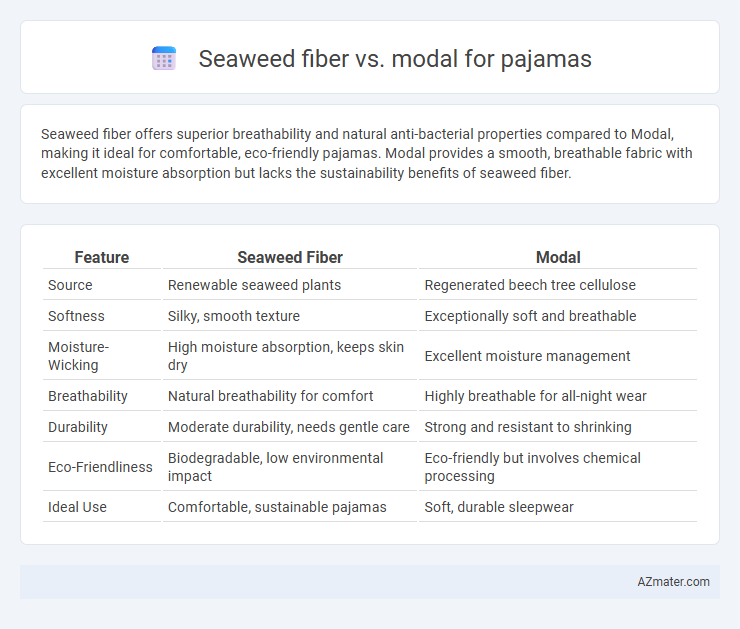Seaweed fiber offers superior breathability and natural anti-bacterial properties compared to Modal, making it ideal for comfortable, eco-friendly pajamas. Modal provides a smooth, breathable fabric with excellent moisture absorption but lacks the sustainability benefits of seaweed fiber.
Table of Comparison
| Feature | Seaweed Fiber | Modal |
|---|---|---|
| Source | Renewable seaweed plants | Regenerated beech tree cellulose |
| Softness | Silky, smooth texture | Exceptionally soft and breathable |
| Moisture-Wicking | High moisture absorption, keeps skin dry | Excellent moisture management |
| Breathability | Natural breathability for comfort | Highly breathable for all-night wear |
| Durability | Moderate durability, needs gentle care | Strong and resistant to shrinking |
| Eco-Friendliness | Biodegradable, low environmental impact | Eco-friendly but involves chemical processing |
| Ideal Use | Comfortable, sustainable pajamas | Soft, durable sleepwear |
Introduction: Seaweed Fiber and Modal Pajamas Overview
Seaweed fiber pajamas are crafted from sustainable algae-based materials known for their natural antibacterial properties and exceptional moisture-wicking capabilities, providing enhanced comfort and skin benefits. Modal pajamas, made from beech tree pulp, offer a soft, breathable fabric with excellent durability and resistance to shrinkage, making them ideal for everyday wear. Both fibers prioritize comfort and sustainability, with seaweed fiber standing out for its eco-friendly extraction process and modal favored for its smooth texture and longevity.
Composition and Production Processes
Seaweed fiber, derived from sustainable seaweed algae through an eco-friendly extraction process, combines cellulose fibers with natural minerals to create a soft, breathable fabric ideal for pajamas. Modal, a type of rayon made from beech tree pulp, undergoes a chemical regeneration process involving sodium hydroxide and carbon disulfide, resulting in a smooth, durable textile known for its moisture-wicking properties. The primary difference lies in seaweed fiber's natural mineral infusion and lower environmental impact during production compared to modal's intensive chemical treatment and reliance on hardwood sources.
Environmental Impact Comparison
Seaweed fiber, derived from sustainably harvested seaweed, offers a biodegradable and renewable alternative with a lower carbon footprint compared to Modal, which is produced from beech tree pulp through a chemically intensive process. The energy and water consumption in Seaweed fiber production are significantly less, contributing to reduced environmental degradation and pollution. Modal's reliance on forestry practices and chemical treatments can lead to deforestation and water contamination, making Seaweed fiber a more eco-friendly choice for sustainable pajama fabrics.
Comfort and Softness: Seaweed Fiber vs Modal
Seaweed fiber offers exceptional moisture-wicking and breathability, creating a naturally cooling and hypoallergenic fabric ideal for pajamas. Modal, derived from beech tree pulp, provides a smooth, silky texture with excellent softness and a luxurious drape that enhances nighttime comfort. Both fibers excel in softness, but seaweed fiber stands out for sustainable comfort and odor control, while modal is prized for its smoothness and durability.
Moisture-Wicking and Breathability
Seaweed fiber excels in moisture-wicking due to its natural hydrophilic properties, efficiently drawing sweat away from the skin to keep pajamas dry and comfortable. Modal, a semi-synthetic fabric made from beech tree pulp, also offers excellent breathability and moisture management, ensuring pajamas remain soft and airy during prolonged wear. Compared to modal, seaweed fiber provides enhanced moisture control with added antimicrobial benefits, making it an ideal choice for pajamas in hot or humid climates.
Skin Sensitivity and Hypoallergenic Properties
Seaweed fiber pajamas offer superior hypoallergenic properties and are ideal for sensitive skin due to their natural antibacterial and moisture-wicking capabilities, reducing irritation and allergic reactions. Modal, made from beech tree cellulose, is soft and breathable but may not provide the same level of skin-friendly benefits as seaweed fiber, particularly for individuals prone to sensitivities. Choosing seaweed fiber pajamas supports healthier skin by minimizing allergens and maintaining optimal comfort throughout wear.
Durability and Longevity in Pajamas
Seaweed fiber offers moderate durability with natural antibacterial properties that help maintain fabric integrity over time, making it suitable for comfortable, eco-friendly pajamas. Modal, a semi-synthetic fiber derived from beech trees, excels in strength and resistance to shrinkage, providing long-lasting softness and shape retention in sleepwear. When comparing pajamas, modal typically outperforms seaweed fiber in durability and longevity, ensuring extended wear and consistent comfort.
Cost and Availability in the Market
Seaweed fiber pajama fabric generally commands higher prices due to its sustainable production processes and limited market availability, reflecting niche eco-conscious demand. Modal, derived from beech trees, benefits from established large-scale manufacturing, resulting in more affordable pricing and widespread availability in retail and wholesale markets. Consumers prioritizing cost-effectiveness often prefer modal pajamas, while those seeking unique eco-friendly textiles may opt for the premium-priced seaweed fiber alternatives.
Washing and Care Instructions
Seaweed fiber pajamas require gentle washing with cold water and mild detergent to maintain their natural softness and prevent fiber breakdown, while avoiding bleach and fabric softeners to preserve their eco-friendly properties. Modal pajamas can withstand machine washing on a gentle cycle using mild detergent but should be air-dried or tumble-dried on low heat to prevent shrinkage and maintain fabric smoothness. Both fabrics benefit from avoiding high heat in drying and ironing to extend the lifespan and comfort of the sleepwear.
Final Verdict: Which Fiber is Best for Pajamas?
Seaweed fiber offers natural antibacterial properties, moisture-wicking capabilities, and eco-friendly benefits, making it ideal for sensitive skin and sustainable sleepwear. Modal, known for its softness, durability, and breathability, provides a luxurious feel and excellent moisture absorption. For pajamas, seaweed fiber excels in skin health and environmental impact, while modal ensures long-lasting comfort and smooth texture, with the best choice depending on personal priorities between sustainability and fabric performance.

Infographic: Seaweed fiber vs Modal for Pajama
 azmater.com
azmater.com